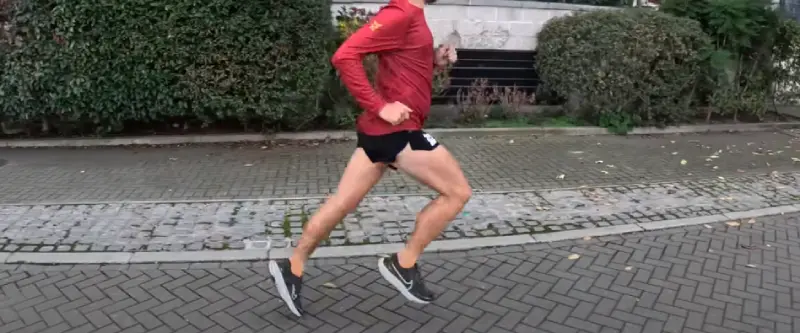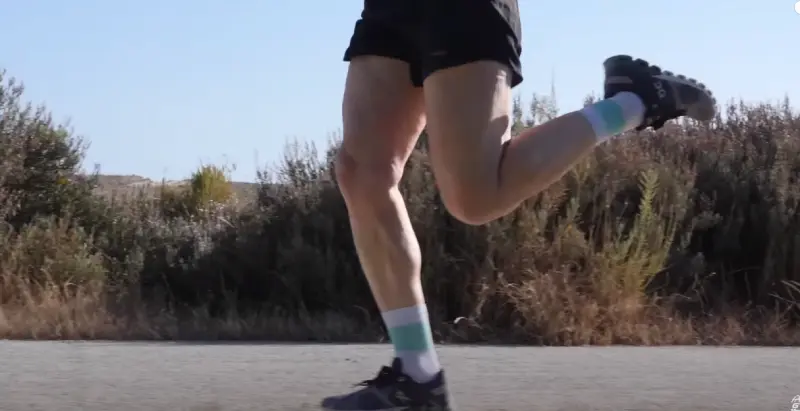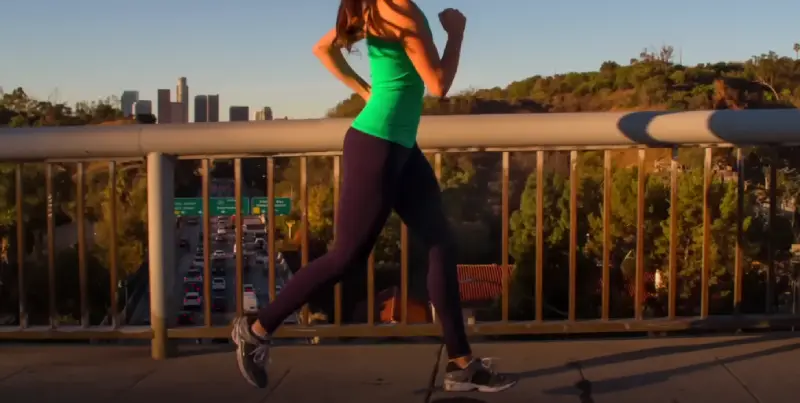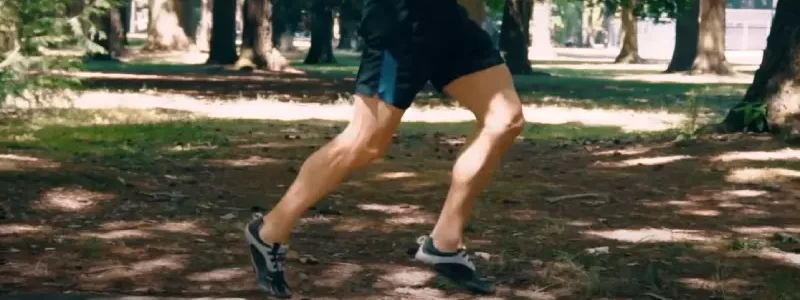The muscles in our legs power our movements. Their development through training significantly affects athletic performance. Cycling and running are two popular physical activities that result in different levels of leg muscle development. Although both activities lead to great fitness, the muscle-strengthening methods differ.
Cycling causes cyclists to develop large, muscular quadriceps because of their chief power output.
Runners experience impact with the ground over long distances, resulting in a more balanced leg muscle development. This leads to less bulky and more elongated muscles.
In this blog post, we will explain the differences between cyclist legs and runner legs.
Cyclist Legs vs Runners Legs: 6 Muscle Facts Unpacked

Cyclists and runners rely heavily on their legs’ strength and endurance, but the demands placed on their lower body muscles differ significantly. These are some of the most critical differences between cyclists’ and runners’ legs.
Anatomy of Muscle Dynamics in Cyclist Legs
A cyclist’s quadriceps dominate his hamstrings, giving it its characteristic appearance. The repetitive motion of pedaling builds strength and endurance in these muscles, contributing to the overall efficiency of the cycling movement.
Quadriceps Dominate the Body
Cyclists are often heralded for their powerful quadriceps, the focal point of energy expenditure in the push-and-pull mechanism of pedaling. The vast medial, lateral, and intermedius, combined with the rectus femoris, form a powerhouse ensemble that defines the kinetic chain in cycling.
✔ Top Pick: Cycling Compression Shorts
Many people use cycling compression shorts to support the quadriceps and reduce muscle fatigue during long rides.
These muscles are honed for repetitive motion and muscular endurance, enabling cyclists to tackle steep inclines and long-distance rides without faltering.
Crafting Muscular Endurance
An endurance cyclist’s legs are crucial to their longevity. While the quadriceps are starting, harmony with the hamstrings and glutes ensures the wheels keep turning. Analysis of cycling’s biomechanics suggests the hamstrings stabilize the knee joint and assist in the rotational movement of pedaling, reinforcing the quadriceps’ efforts with every revolution.
Runner’s Legs Muscle Dynamics: A Balanced Approach
Running is considered a full-body workout but favors balanced muscle development across different leg groups.
Unlike cycling’s focus on the quadriceps, running’s varied terrain and paces demand engagement from multiple muscle sets, excluding none for too long, allowing for more uniform leg development.
Equilibrium of Running
Runners, in contrast, develop a more balanced leg musculature. The glutes, hamstrings, quadriceps, and calves all share the load, adapting to the varied impact forces and planes of motion that running entails.
✔ Top Pick: Running Compression Tights
Many runners use compression tights to support balanced leg muscles and improve circulation during training.
This balanced approach equips runners for various conditions and lowers the risk of overuse injuries that can plague specialized athletes with muscle imbalances.
Curious Case of Hamstring Strength
While cyclists push themselves to perfection in quadriceps development, runners rely heavily on the strength of their hamstrings for propulsion. During the powerful drive phase, as the foot leaves the ground, the hamstrings contract forcefully, propelling the body’s center of mass forward.
This highlights the necessity for balanced muscle development among runners, with the hamstrings being a pivotal focus for speed and agility.
Training Techniques and Muscle Dynamics

The differences in training methodologies for cyclists and runners further magnify the contrast in their leg muscle development. With their varied outdoor terrain, runners engage in more balanced training since they do intervals and high-resistance workouts.
Tailoring Workouts to the Sport
Cyclists and runners often follow divergent training philosophies. Cycling supports interval training and time trials to push lactic acid thresholds and sculpt endurance-based muscles.
In contrast, runners focus on mileage, tempo runs, and speed work, balancing interspersed rest and recovery to allow their more versatile leg muscles to adapt.
Volume, Intensity, and Style of Training
Understanding the impact of training variables on muscle dynamics is crucial. For cyclists, high-volume training can contribute to quadriceps hypertrophy, while low-cadence, high-resistance efforts can target strength development.
Runners must carefully balance the volumes of speed, endurance, and recovery runs to optimize their sprint, recovery, and distance capabilities.
Muscle Dynamics and Injury Prevention
Injury prevention is one of the most critical aspects of athletic performance, and maintaining balanced muscle dynamics is vital.
Because of their muscular engagement, cyclists and runners are both susceptible to particular injuries, and imbalances amplify the risk.
Dual-Edged Sword of Muscle Imbalance
Specialization in one sport can lead to muscle imbalances, which, if not addressed, can increase the risk of injury.
Cyclists may develop anterior pelvic tilt and tight hip flexors, leading to lower back pain, runners may have issues with hamstrings.
Recognizing and rectifying these imbalances through cross-training and targeted exercises is paramount for longevity in one’s sport.
Strategies for Balanced Muscle Development
Injury prevention strategies should be integrated into an athlete’s routine to minimize the impact of muscle imbalance.
Strength training, incorporating compound movements such as squats and deadlifts, can ensure that the supporting cast of leg muscles keeps pace with their more dominant counterparts.
Stretching and mobility exercises help maintain a healthy range of motion, essential for peak performance.
✔ Top Pick: Foam Roller
Many athletes use a foam roller to release tight muscles and maintain flexibility after intense workouts.
Impact of Leg Length on Muscle Dynamics

The debate on cyclists’ legs versus runners’ legs also considers the influence of leg length. Longer legs in the running can yield more stride, while shorter legs in cycling lead to a more efficient pedal cadence and reduced air resistance.
Role of Anatomy in Performance
Cyclists with shorter legs often benefit from a more aerodynamic position on the bike, requiring less wind resistance. This can lead to more efficient pedaling mechanics and the potential for more significant acceleration.
Meanwhile, runners with longer legs may find that their stride length offers a natural advantage in specific running disciplines, requiring fewer steps to cover the same distance.
Leveraging Length for Competitive Edge
Understanding and leveraging one’s leg length can provide valuable insights for tailoring training and techniques for optimal performance.
Cyclists with shorter legs might focus on high-cadence pedaling to maximize efficiency, while runners with a longer stride can exploit this natural gift through speed training and cadence monitoring.
Conclusion
The final pedal stroke or stride in an event is a culmination of training, technique, and tenacity. This analysis has shed light on the divergent paths of leg muscle development for cyclists and runners, revealing that each sport has unique requirements and nuances. By recognizing these differences and tailoring training regimens to address specific needs, athletes can fine-tune their muscle dynamics for peak performance.
The challenges cyclists and runners face extend far beyond the track or the trail into the fiber of their leg muscles. By understanding the effects of training, body anatomy, and potential risks of muscle imbalances, athletes can ensure their legs lead them to victory rather than to injury or underperformance.
FAQs
How Do Runner’s Legs Differ From Biker’s Legs?
Runners have a more balanced development of quadriceps, hamstrings, glutes, and calves compared to cyclists. Cyclists typically have stronger quadriceps due to the continuous stress of pedaling, which can lead to overdeveloped quads and potential injury risks. In contrast, runners maintain a more evenly distributed muscle profile in their legs.
What Can I Do to Get Rid of Foot Cramps?
To alleviate cramps, gently and firmly stretch your foot by flexing it and pressing down on the big toe. Moving around and shaking your leg can also provide relief for both foot and leg cramps.
For any lingering discomfort, consider taking a warm bath or shower, applying ice, or even trying a deep tissue massage for long-term benefits.


